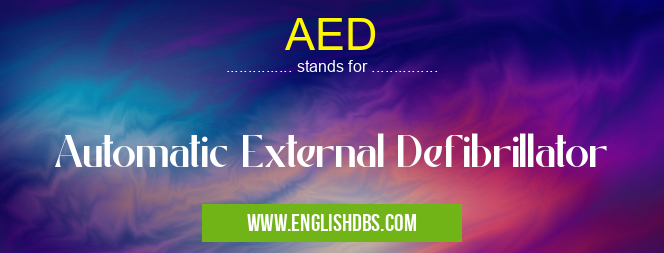What does AED mean in PHYSIOLOGY
An Automatic External Defibrillator (AED) is a medical device that can be used to deliver an electric shock to the heart of a person who has gone into cardiac arrest. The purpose of this shock is to reestablish the normal electrical activity of the heart and ultimately restore the person's life. AEDs are found in many public places such as airports, shopping malls, schools, stadiums and other venues. With their portability and convenience, more people are able to access these devices when needed.

AED meaning in Physiology in Medical
AED mostly used in an acronym Physiology in Category Medical that means Automatic External Defibrillator
Shorthand: AED,
Full Form: Automatic External Defibrillator
For more information of "Automatic External Defibrillator", see the section below.
» Medical » Physiology
Uses
AEDs can be used by both medical professionals and laypersons alike. They provide clear audio instructions on how to use the device and what needs to be done until help arrives. In most cases, they only require two steps; attaching adhesive electrodes on the victim's chest and pressing a button or switch that triggers the defibrillation process. As long as they are available and properly maintained, these devices have been successful in saving lives all around the world. It is important for non-medical personnel who may come across an AED to understand basic first aid principles so that they can adequately assess the situation of a cardiac arrest victim before using an AED. Additionally, it is advisable for those same individuals to continue with CPR until professional medical help arrives on scene if needed.
Advantages
The main advantage of using AEDs is that they are very easy to use even without any prior experience or medical knowledge. Their automated features make them very reliable tools for providing basic life-saving support during a medical emergency involving cardiac arrest. Other benefits include their portability, which allows them to be transported from one location to another quickly in order for victims of sudden cardiac arrest (SCA) in remote areas receive help faster than ever before possible. In addition, they are designed with safety measures put in place so as not to cause further injury or harm if used inappropriately due to panic or lack of understanding about SCA care techniques.
Essential Questions and Answers on Automatic External Defibrillator in "MEDICAL»PHYSIOLOGY"
What is an AED?
An AED, or Automatic External Defibrillator, is a device used to administer electric therapy to the heart in order to restore a normal heartbeat if it has entered into a life-threatening arrhythmia.
Who Can Use an AED?
Anybody can use an AED. Generally, people who are trained in its use should be the ones that operate the device. However many devices come with simple visual and/or audio instructions which can help walk an untrained person through the steps of administering electric shock therapy.
Where Can I find an AED?
Most public facilities such as airports, banks, shopping malls, schools, restaurants and sports arenas often have AEDs available for emergency use. Additionally, many ambulances and firetrucks carry them.
How Much Does an AED Cost?
An AED will vary in price depending on the model you choose and which features you opt for. Prices usually range from $1,200-$2,000.
How Do I Know If My AED Is Working Properly?
You should make sure that your device is regularly inspected to ensure it's in proper working order and that all necessary components such as electrodes and batteries are functioning correctly. Additionally it's important that your device remains up to date with any software updates issued by the manufacturer of your device.
Does An AED Need To Be Plugged In?
No! Most modern external defibrillators are battery operated and do not need to be connected to a power source when in use. This makes them highly portable so they can be taken anywhere where there may be need for their medical assistance.
How Do I Dispose Of An Old Or Used Up AED Unit?
As with any medical device or equipment containing lithium ion batteries there are special protocol regarding disposal methods and how these items should be handled prior to being discarded properly. It's important that you refer to your local authority regarding proper procedures for disposing of old or used up units so that environmental damage is avoided.
Final Words:
In conclusion, Automatic External Defibrillators (AEDs) provide an invaluable service by reducing response times and providing those affected with life-saving measures when it comes to treating sudden cardiac arrest emergencies quickly and effectively. With proper maintenance and training sessions conducted regularly on how they are used safely, more lives will be saved due mostly in part because these devices lend themselves well towards quick rescue operations at any given time regardless of location or circumstances surrounding the incident.
AED also stands for: |
|
| All stands for AED |
